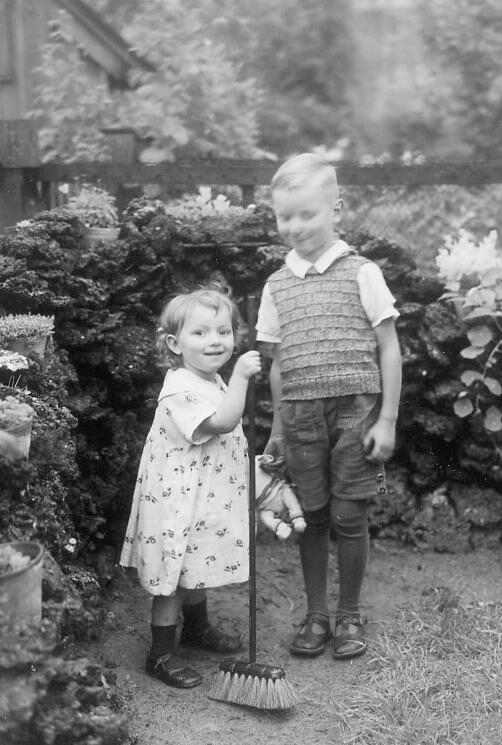
Long Stocking Gender Conventions: Chronology--20th Century

Figure 1.--Both boys and girls wore long stockings. The primary difference seemns to have been color. Interestingly while both boys and girls wore them, on any given day there seems to have been considerable variatin een within a family that had nothing to do with gender. Here we see a 1935 German family backyard snapshot. The boy wears long stockings whilecthe girl wears ankle socks.
|
|
Until the early 20th century women wore floor-length or at least ankle-length gowns, so the only part of their stockings that were exposed were the ankles. Women's stockings therefore didn't have to be very long because only a small part of the lower leg would ever show. This all changed about the second decade of the 20th century at which point women's dresses got shorter and shorter, exposing more and more of their legs, whereas men changed to socks which didn't need to be much higher than mid-calf. Boys, however, continued to wear knee pants, knickers, or short pants with long stockings much later because up until about 1950 (especially in Europe), it was not considered proper for boys to wear long trousers until about age 14. I was born in 1927 and was not allowed to wear long trousers until I was 14. Getting one's first long pants was a big deal in the 1920s and 1930s, and some conservative parents didn't allow boys to dress in long trousers until their final year in highschool. In some countries such as Germany and Russia, boys were still wearing short trousers, often with long stockings, as late as 16 and 17. A number of alterations in cultural attitudes seem to lie behind these changes. Greater and greater informality led to much more casual clothing for everybody--of both sexes--and also for children. And children's dress, especially short trousers and long stockings for boys, gave way to dressing children pretty much the way adults dressed, thus erasing the symbolic distinction between childhood and manhood (in terms of clothing). With the gradual sexual revolution and the increasing power and equality of women, came less modest dress for the feminine sex. Whereas it would have been considered obscene for women in the Victorian period to show their upper legs, it started to be "daring" to do so in the roaring 1920s, and some women wore their skirts so short that their garters began to be suggestively exposed on certain occasions. But it was this very trend that boys, who also had to wear the same kind of garters with their long stockings, began to hate because they didn't want to be dressed like girls or like their mothers, and they were sometimes embarassed about their garters showing under short trousers. Remember that in the 19th century boys often wore the same dresses as their sisters until about age 4 or 5 when they were "breeched" and began wearing trousers. Long stockings for boys have now disappeared almost completely, even in northern Europe, although in Russia and Germany and Japan, boys still wear tights under short pants for dressy occasions. An interesting survival of long stockings for men is in the game of ice hockey, where garter belts are still worn under short pants to hold up the long woolen stockings worn with the uniform (although the shorts are no longer as short as they used to be and velcro straps have begun in some cases to replace the more conservative garter belts with fasteners).
HBC

Navigate Related Hosiery Pages:
[Return to the main Main long stocking stocking gender chronology page]
[Return to the main Main stockings gender trends page]
[Return to the main Long stockings]
[Return to the main hosiery page]
[Knee socks]
[White knee socks]
[Striped socks]
[White stockings]
[Tights]
Navigate the Historic Boys' Clothing Web Site:
[Introduction]
[Activities]
[Biographies]
[Chronologies]
[Countries]
[Style Index]
[Bibliographies]
[Contributions]
[FAQs]
[Links]
[Glossaries]
[Images]
[Links]
[Registration]
[Tools]
[Boys' Clothing Home]
Created: 4:16 PM 11/9/2008
Last updated: 4:16 PM 11/9/2008



